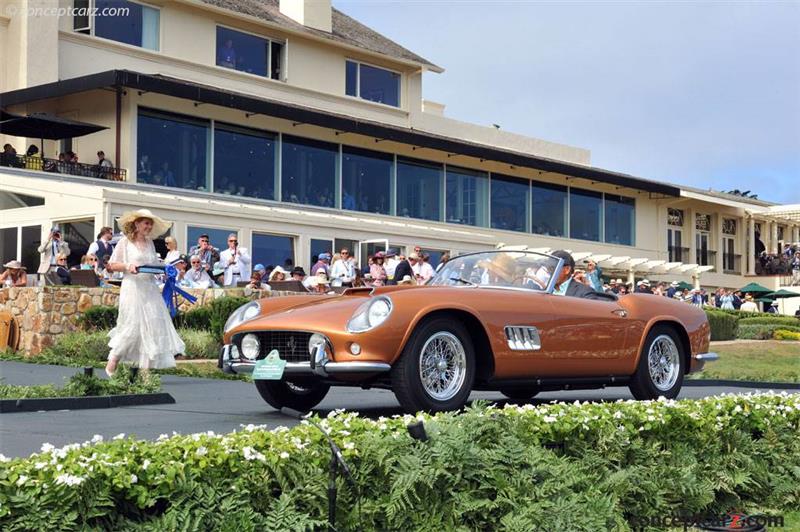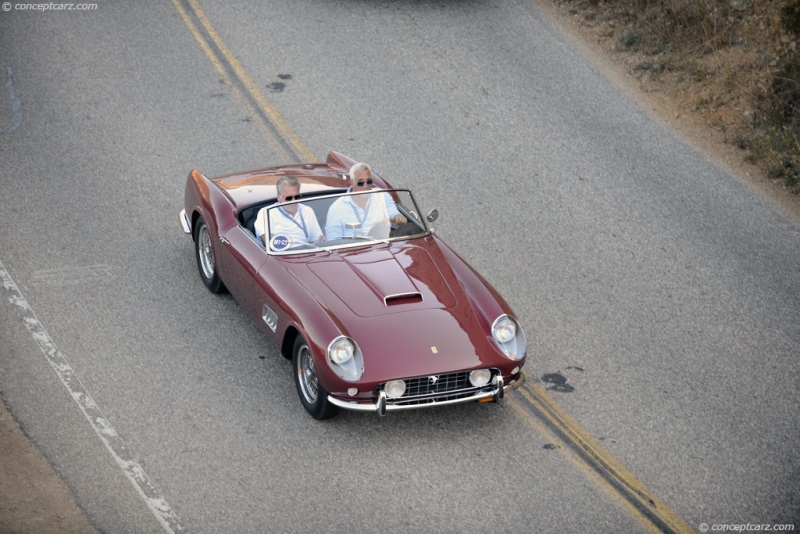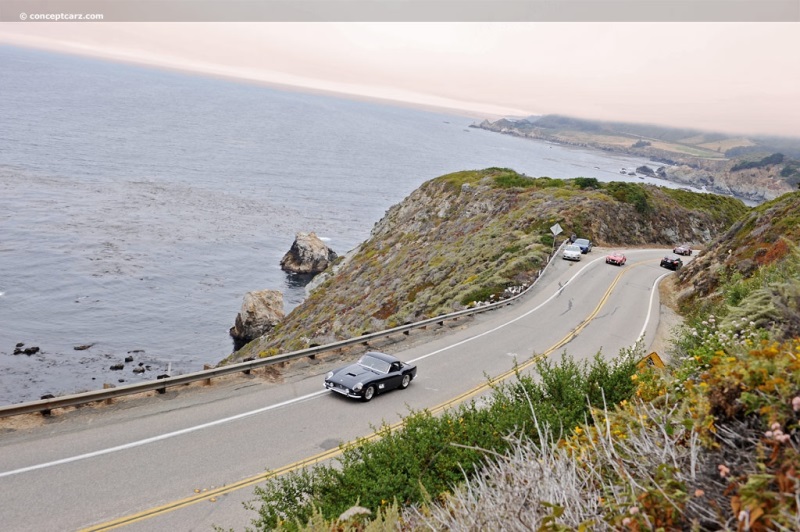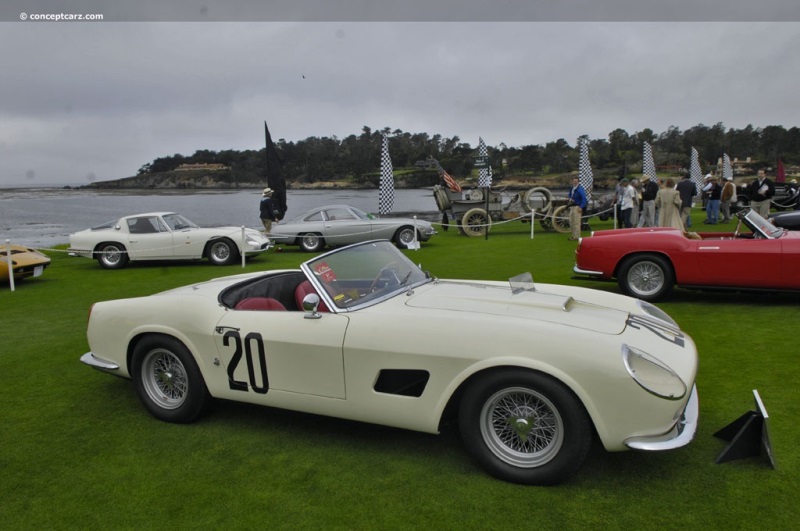The dual-purpose 250 GT platform found remarkable success in road-going guise and in sports car competition, with its level of cachet and cultural appreciation unrivaled in the automotive spectrum. Its legacy was formed at the forefront of motorsports, with road-going variants benefitting from race-derived engineering. Its beauty, poise, and stunning presence were shaped by the wind, penned by some of the greatest designers of all time, and delicately hand-formed by skilled craftsmen. Among the most memorable and treasured variants from the 250 series was the open 250 GT model designed for the booming North American market. It was a simple, youthful, high-performance, dual-purpose 250 GT convertible with striking 'spider' coachwork designed by Pinin Farina and bodied by Carrozzeria Scaglietti. Known as the Ferrari 250 Granturismo Spider California, its targeted clientele were wealthy enthusiasts seeking a stylish, thoroughbred sports car that was equally at home on the road and track. Between 1957 and 1963, Ferrari built 106 California Spiders, including 50 of the original long-wheelbase (LWB) version and 56 of the final short-wheelbase (SWB) variant. True today as when they left the factory, the California Spider remains one of the most iconic and desirable Ferraris ever produced.The 250 Series
The 250 Series nomenclature represented the displacement of a single cylinder of the 2,953cc (180 cubic-inch / 3.0-liter) engine. The 250 Series was Ferrari's most successful early line of automobiles designed for road use or sports car racing. Revealed to the public in 1953 at the Paris Auto Salon alongside the 375 America, the 250 Europa would become Ferrari's first true grand touring automobile. It was the only variant within the 250 series to carry the Aurelio Lampredi-designed V-12 engine which had previously found use in competition Ferraris. All 250 GT iterations that followed received the more compact Gioacchino Colombo-designed 60-degree, 3.0-liter V12 engine. Initially fitted with a bank of three twin-choke Weber carburetors and mated to a four-speed, all-synchromesh gearbox, it produced a claimed 220 horsepower. In the Testa Rossa and GTO variants, output reached upwards of 300 horsepower.
Spyder by Scaglietti
Chassis #: 2015 GT
View info and historyThe 250 Series brought a degree of production uniformity and profitability to the Ferrari marque, and most 250 road cars rested on either a short 94.5-inch wheelbase (SWB) or a longer 102.4-inch wheelbase (LWB) platform. The prevailing body style for the series was the sporty Berlinetta. The coachbuilder Boano introduced a new open Ferrari built on the 250 GT platform in March 1956, and the following year, Pinin Farina unveiled a more refined version with a completely stowable top, rounded fenders, covered headlamps, and a notched driver's-side door. The 250 GT Cabriolet Pinin Farina Series I
Catering to special requests put forth by Ferrari's most important clients, the 250 GT Cabriolet Series I was a luxurious open-top model with wind-up windows and Borrani wire wheels. The coachwork remained essentially unchanged through the production of 37 examples (plus three prototypes for a total of 40), though the final few received uncovered headlamps. These first-series 250 GT Cabriolets were one of the last models constructed in Pinin Farina's boutique workshop prior to the coachbuilder's relocation to a larger factory in Grugliasco. Many mechanical components of these cabriolets were shared with the concurrent 250 GT Berlinetta 'Tour de France'. The bodies were consistent from car to car, but the interior details, accouterments, and trim were customized to order. Thus, referring to the 40 Pinin Farina Cabriolets produced between 1956 and 1959 is somewhat misleading since each of these was unique in detail in character.The 250 GT Cabriolet Pinin Farina Series I
Introduced in October 1959 as the successor to the Series I Cabriolet, the Series II Cabriolet benefited from newly introduced four-wheel Dunlop disc brakes, an outside-plug V12 engine, and a four-speed gearbox with electric overdrive. Its understated styling mirrored the contemporary Pinin Farina-bodied 250 GT coupe, and with its luxurious and well-appointed interior, it was ideally suited for comfortable long-distance touring. A total of 200 Series II Cabriolets were built by Pinin Farina through 1962.The California Spider
The introduction of the California spider could be viewed as redundant since Ferrari's 250 Series already contained a drop-top body style - the Series I Cabriolet. Its purpose, however, differed as the Series I favored luxury while the California Spider was closer in specification and design to the company's competition models.
Spyder by Scaglietti
Chassis #: 1963GT
Engine #: 1963GT
View info and history
Auction entries : 1Luigi Chinetti and John von Neumann were Ferrari's two most successful and influential dealers, and their requests for a simple, dual-purpose 250 GT convertible birthed the 250 GT California Spider. Numerous other marques had proven the market potential of this formula, several with fiberglass bodies. Similarly, an American importer of luxury European automobiles named Max Hoffman was instrumental in the development of several iconic luxury sports cars, including the Porsche 356 Speedster and V-8 powered BMW 507 roadster.Mechanical Specification
The elliptical section steel tubular frame chassis of the California Spyder mirrored conventional Ferrari practice with an initial wheelbase size of 102.4 inches (2600mm), later shrinking to 94.5 inches (2400 mm). With the shorter wheelbase, its track was widened, and its ground clearance was reduced. The suspension was independent at the front with coil springs, while the live rear axle had semi-elliptical leaf springs. In 1960, telescopic shock absorbers replaced the Houdaille torsion bars at the front. Drum brakes were used until October 1959 when they were replaced in favor of Dunlop discs.
Spyder by Scaglietti
Chassis #: 1963GT
Engine #: 1963GT
View info and history
Auction entries : 1The Ferrari 'Colombo' 12-cylinder V-engine had two overhead camshafts and two valves per cylinder, light alloy construction, and a 3.0 liter (2,953cc) displacement size. With a trio of Weber 36 DCL6 carburetors (36 millimeters), it produced 240 horsepower at 7,000 RPM. From 1960 onwards, 42 millimeter (DCL/6) carburetors were used, and with larger valves and new cylinder heads, output increased to 280 horsepower. In 1960, the spark plugs were relocated outside the V, as in the 250 Testa Rossa. Body Design
The body design was penned by Pinin Farina and hand-built by Carrozzeria Scaglietti in its Modena workshop, as were most Ferrari competition models of the time. Early California Spiders were constructed of steel with an alloy hood and deck lid, with styling elements that included single-piece side vents, Tour de France-type taillights, Marchal driving lamps (unlike the cabriolet), a wept-back windshield, fog lights in the grille, and single-piece bumpers. The design could be optioned with covered or open headlights, and the bodies of later examples could be formed from lightweight aluminum coachwork. The short wheelbase version with the widened track and lower stance had a more compact and muscularized silhouette. The long wheelbase version is generally regarded as being more elegant with a cleaner line and a more tailored appearance. The air intake on the SWB hood differed from the LWB version by being half-recessed.
Spyder by Scaglietti
Chassis #: 1963GT
Engine #: 1963GT
View info and history
Auction entries : 1Interior
The instrument panel used the same pattern and layout as the Series 1 Pinin Farina Cabriolet, with a large speedometer and tachometer facing the driver and the smaller ancillary gauges off to the side in a line. There was a lightweight folding top, a three-spoke Nardi steering wheel made of wood and aluminum, bucket seats, and minimal accouterments. Competition
Faithful to its original concept, the California Spider achieved a remarkable degree of success at the track, including class wins at Le Mans and Sebring, along with numerous victories in SCCA B-Production events. Richie Ginther and Howard Hively claimed the class victory at the 12 Hours of Sebring in 1960, and Giorgio Scarlatti, Fabrizio Serena and Carlo Abate in 1960. The North American Racing Team placed fifth in the 1959 24 Hours of Le Mans with drivers Bob Grossman and Fernand Tavano.Production
The Ferrari 250 GT California Spyder was produced from 1957 to 1963 with 106 examples built, with 50 on the original long-wheelbase (LWB) platform and 56 on the final short-wheelbase (SWB) chassis.
by Daniel Vaughan | Jan 2024
The 250 Series nomenclature represented the displacement of a single cylinder of the 2,953cc (180 cubic-inch / 3.0-liter) engine. The 250 Series was Ferrari's most successful early line of automobiles designed for road use or sports car racing. Revealed to the public in 1953 at the Paris Auto Salon alongside the 375 America, the 250 Europa would become Ferrari's first true grand touring automobile. It was the only variant within the 250 series to carry the Aurelio Lampredi-designed V-12 engine which had previously found use in competition Ferraris. All 250 GT iterations that followed received the more compact Gioacchino Colombo-designed 60-degree, 3.0-liter V12 engine. Initially fitted with a bank of three twin-choke Weber carburetors and mated to a four-speed, all-synchromesh gearbox, it produced a claimed 220 horsepower. In the Testa Rossa and GTO variants, output reached upwards of 300 horsepower.
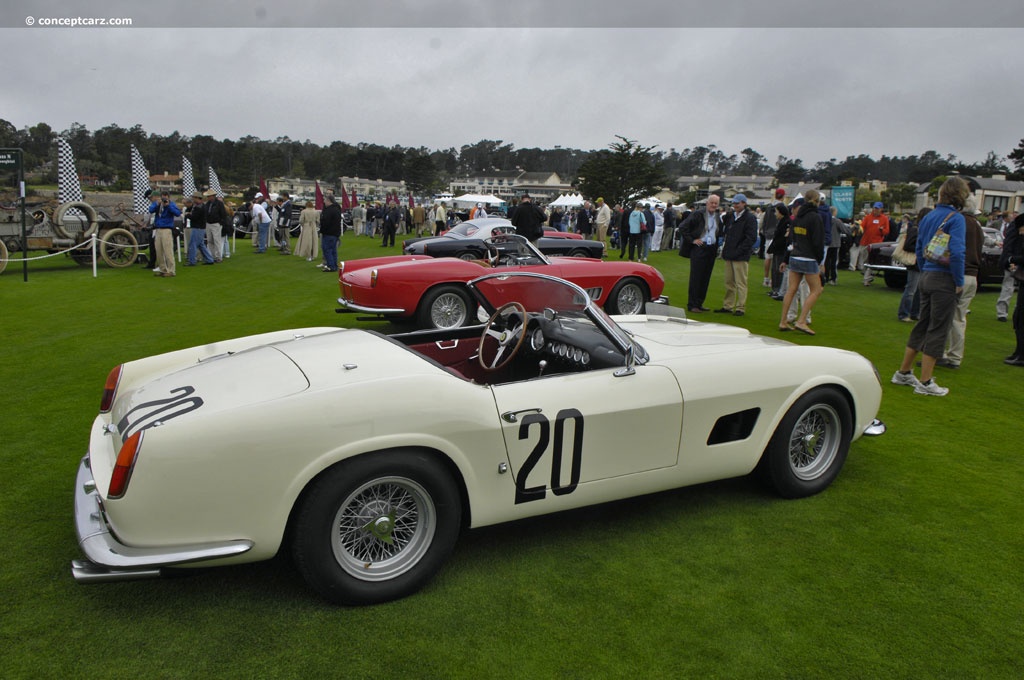
Spyder by Scaglietti
Chassis #: 2015 GT
View info and history
Catering to special requests put forth by Ferrari's most important clients, the 250 GT Cabriolet Series I was a luxurious open-top model with wind-up windows and Borrani wire wheels. The coachwork remained essentially unchanged through the production of 37 examples (plus three prototypes for a total of 40), though the final few received uncovered headlamps. These first-series 250 GT Cabriolets were one of the last models constructed in Pinin Farina's boutique workshop prior to the coachbuilder's relocation to a larger factory in Grugliasco. Many mechanical components of these cabriolets were shared with the concurrent 250 GT Berlinetta 'Tour de France'. The bodies were consistent from car to car, but the interior details, accouterments, and trim were customized to order. Thus, referring to the 40 Pinin Farina Cabriolets produced between 1956 and 1959 is somewhat misleading since each of these was unique in detail in character.The 250 GT Cabriolet Pinin Farina Series I
Introduced in October 1959 as the successor to the Series I Cabriolet, the Series II Cabriolet benefited from newly introduced four-wheel Dunlop disc brakes, an outside-plug V12 engine, and a four-speed gearbox with electric overdrive. Its understated styling mirrored the contemporary Pinin Farina-bodied 250 GT coupe, and with its luxurious and well-appointed interior, it was ideally suited for comfortable long-distance touring. A total of 200 Series II Cabriolets were built by Pinin Farina through 1962.The California Spider
The introduction of the California spider could be viewed as redundant since Ferrari's 250 Series already contained a drop-top body style - the Series I Cabriolet. Its purpose, however, differed as the Series I favored luxury while the California Spider was closer in specification and design to the company's competition models.
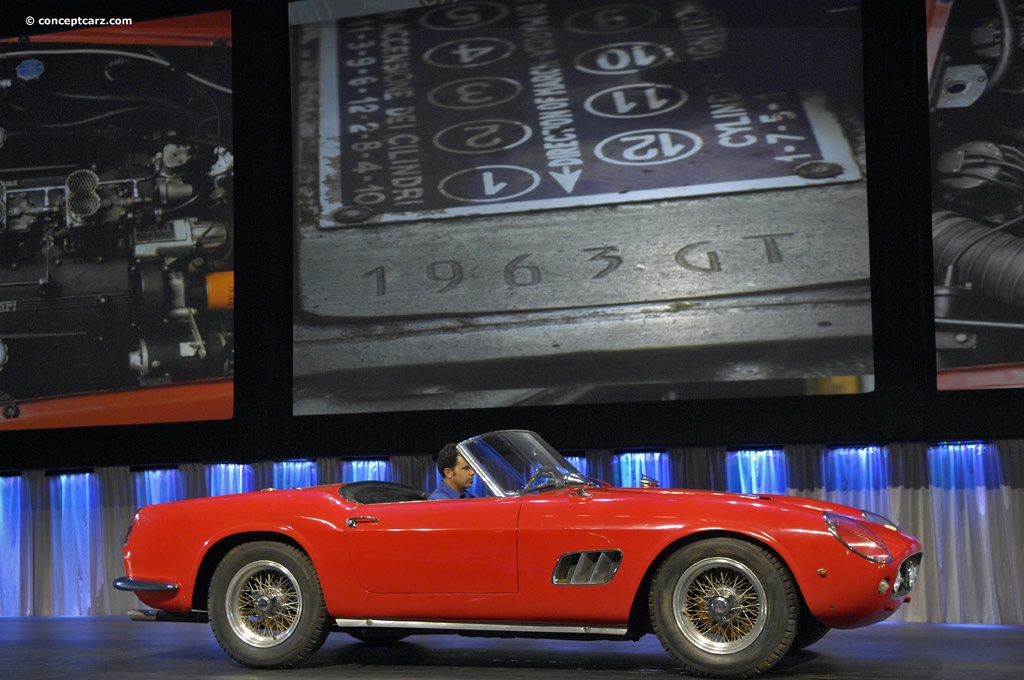
Spyder by Scaglietti
Chassis #: 1963GT
Engine #: 1963GT
View info and history
Auction entries : 1
The elliptical section steel tubular frame chassis of the California Spyder mirrored conventional Ferrari practice with an initial wheelbase size of 102.4 inches (2600mm), later shrinking to 94.5 inches (2400 mm). With the shorter wheelbase, its track was widened, and its ground clearance was reduced. The suspension was independent at the front with coil springs, while the live rear axle had semi-elliptical leaf springs. In 1960, telescopic shock absorbers replaced the Houdaille torsion bars at the front. Drum brakes were used until October 1959 when they were replaced in favor of Dunlop discs.
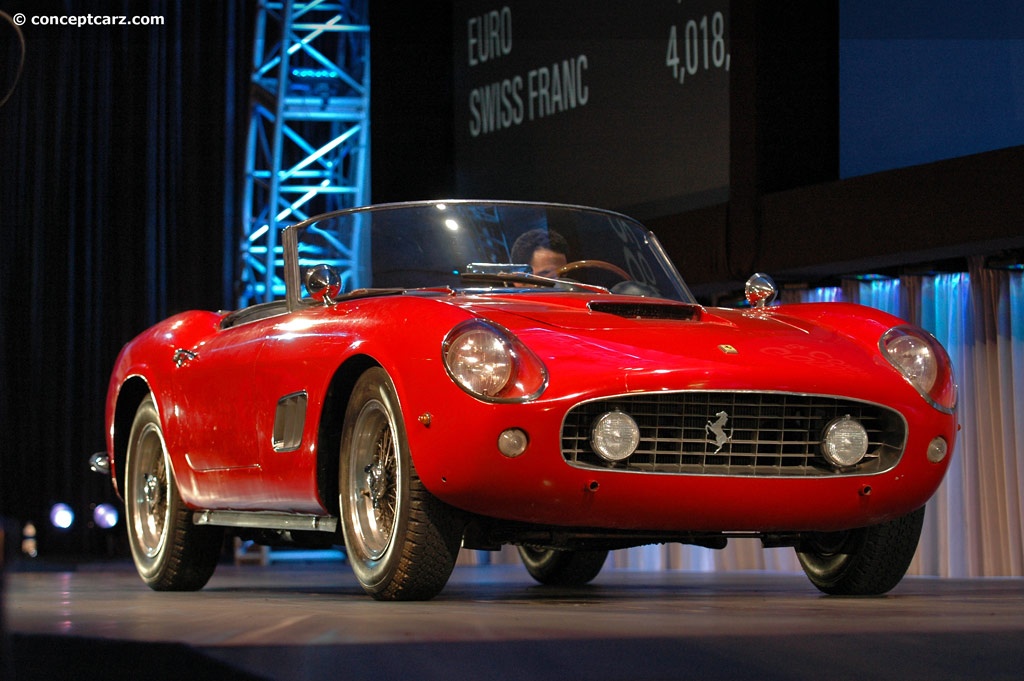
Spyder by Scaglietti
Chassis #: 1963GT
Engine #: 1963GT
View info and history
Auction entries : 1
The body design was penned by Pinin Farina and hand-built by Carrozzeria Scaglietti in its Modena workshop, as were most Ferrari competition models of the time. Early California Spiders were constructed of steel with an alloy hood and deck lid, with styling elements that included single-piece side vents, Tour de France-type taillights, Marchal driving lamps (unlike the cabriolet), a wept-back windshield, fog lights in the grille, and single-piece bumpers. The design could be optioned with covered or open headlights, and the bodies of later examples could be formed from lightweight aluminum coachwork. The short wheelbase version with the widened track and lower stance had a more compact and muscularized silhouette. The long wheelbase version is generally regarded as being more elegant with a cleaner line and a more tailored appearance. The air intake on the SWB hood differed from the LWB version by being half-recessed.
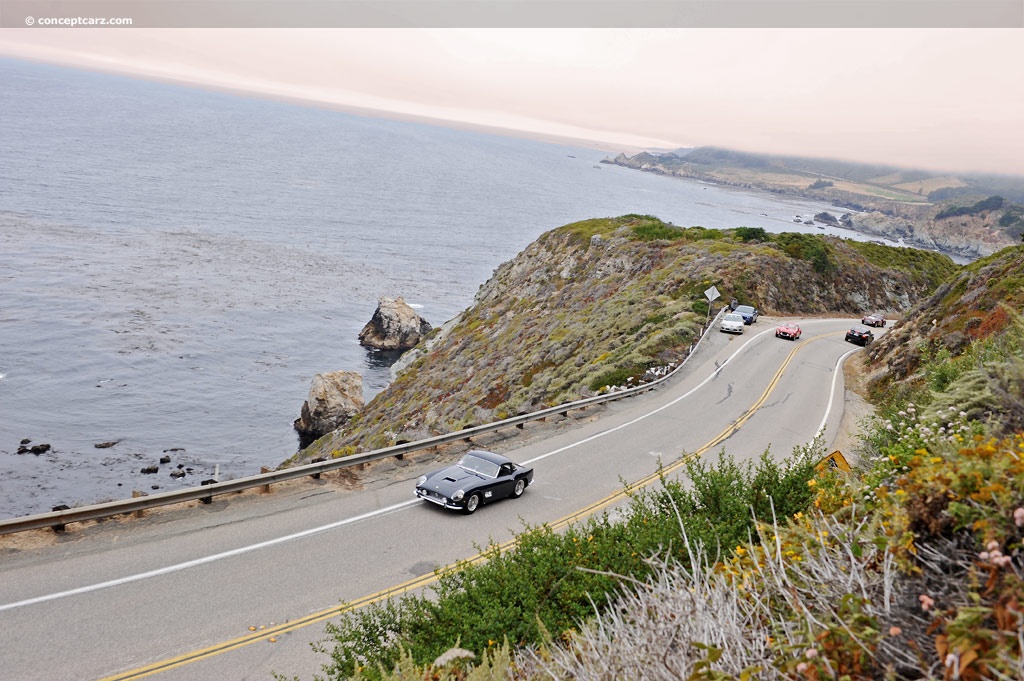
Spyder by Scaglietti
Chassis #: 1963GT
Engine #: 1963GT
View info and history
Auction entries : 1
The instrument panel used the same pattern and layout as the Series 1 Pinin Farina Cabriolet, with a large speedometer and tachometer facing the driver and the smaller ancillary gauges off to the side in a line. There was a lightweight folding top, a three-spoke Nardi steering wheel made of wood and aluminum, bucket seats, and minimal accouterments. Competition
Faithful to its original concept, the California Spider achieved a remarkable degree of success at the track, including class wins at Le Mans and Sebring, along with numerous victories in SCCA B-Production events. Richie Ginther and Howard Hively claimed the class victory at the 12 Hours of Sebring in 1960, and Giorgio Scarlatti, Fabrizio Serena and Carlo Abate in 1960. The North American Racing Team placed fifth in the 1959 24 Hours of Le Mans with drivers Bob Grossman and Fernand Tavano.Production
The Ferrari 250 GT California Spyder was produced from 1957 to 1963 with 106 examples built, with 50 on the original long-wheelbase (LWB) platform and 56 on the final short-wheelbase (SWB) chassis.
by Daniel Vaughan | Jan 2024
Related Reading : Ferrari 250 GT History
Production of the 250 Series began in 1954 and continued on through the early part of the 1960s. There were numerous variations of the 250 and would ultimately become Ferraris most successful line of vehicles to date. The 250 is also recognized as the first Ferrari to ever receive disc brakes. This did not take place until the end of the 1950s. Also, the 250 was the first four-seater. Ferraris....
Continue Reading >>
Continue Reading >>
Similar Automakers
1960 Ferrari 250 GT California Vehicle Profiles
Recent Vehicle Additions
Performance and Specification Comparison
250 GT LWB California Specification Comparison by Year
Year
Production
Wheelbase
Engine
Prices
Related Automotive News

The Only Ferrari 250 GT California Spider To Race The Targa Florio In Period Heads To Auction In Monterey
RM Sothebys adds a significant blue-chip Ferrari to its Monterey Car Week lineup the 1960 Ferrari 250 GT SWB California Spider by Scaglietti, chassis 1883 GT, will be offered 17 – 19 August
Exhibited by Ferrari at the 1960 Turin Moto...

Pebble Beach Auctions Online Catalogue Now Live; Historic, Unrestored 1962 Ferrari 250 GT SWB Berlinetta Unveiled as Headlining Car
Gooding %26 Company launches its entire online catalogue for the Pebble Beach Auctions, announces a remarkably original 1962 Ferrari 250 GT SWB Berlinetta along major Italian star cars.
Gooding %26 Company, the official auction house of the Pebble...

1962 Ferrari 250 GT SWB California Spider to Lead Gooding & Company's Amelia Island Auctions Alongside Stable of the Finest Ferraris
The star car of the auctions will be a one-off 1962 Ferrari 250 GT SWB California Spider, joined by a 250 GT Tour de France Berlinetta, a 250 MM Vignale Spider, and other examples of Maranellos finest models.
Leading international auction...

Gooding & Company Unveils Online Catalogue for Pebble Beach Auctions, Announces Additional Star Consignments
The catalogue features major new additions from the auction house, including a 1959 Ferrari 250 GT LWB California Spider Competizione, a 1998 Mercedes-Benz AMG CLK GTR Strassenversion, a 1957 Maserati 200 SI, and a 1961 Aston Martin DB4 GT.
The...

Gooding & Company Presents Three Significant Competition Ferrari Berlinettas At The Company's 15Th Annual Pebble Beach Auctions
These three cars showcase Ferraris lineage of competition GT cars. Selections include the 1966 Ferrari 275 GTBC, the 1959 Ferrari 250 GT Tour de France, and the 1950 Ferrari 166 MM195 S Berlinetta Le Mans.
Santa Monica, Calif. (June 28,...

Remarkably Pure Ferrari 166 MM Completes RM Sotheby's Stellar Offering at Amelia Island
RM Sothebys rounds out superlative Amelia Island catalogue with an exceptionally pure 1950 Ferrari 166 MM Barchetta
A two-time Mille Miglia entrant, chassis 0058 M is the latest in a series of multi-million-dollar entries confirmed for RM Sotheb...
























